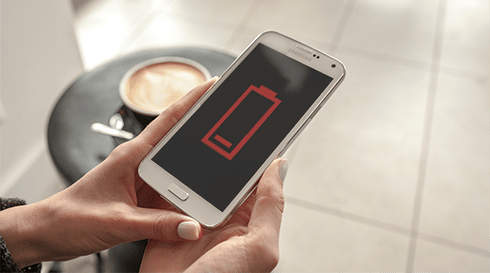The obsolescence of our mobile devices (PC, smartphones but also connected objects) is now a known, worrying phenomenon and that many people are experiencing. But let’s analyze together the “why” of this obsolescence. And yet, we have a simple answer for you: the strong call of the battery.
The batteries of our mobile devices are mainly lithium-ion technologies. The chemistry of those batteries leads to a certain lifespan. This lifetime is difficult to predict; the parameters influencing the battery life being numerous: charge / recharge cycle, temperature, solicitation…
Manufacturers announce 1,000 cycles before the end of battery life. At 500 cycles, the battery capacity has already decreased by 20%. Considering the daily recharges of our smartphones, we can estimate the battery’s life at around 3 years. But it’s possible to feel a greater loss of capacity before this time, and want to change the battery, or even the smartphone before. Hence a strong cause of obsolescence.
This phenomenon would not be so serious if it only had an economic impact. However, it’s not negligible from the ecological point of view. Smartphones and mainly batteries have a strong environmental impact, especially due to their manufacture. 85% of their impact in C02 equivalent comes from the manufacturing phase.
What about the use of the phone in all this?
The charging and discharging cycles of the phone depend on how you use your phone. Not only the number and duration of your calls: smartphones have become our life support, all applications and services that will be on your phone will have a share of consumption.
One of the solutions is to change the uses and behaviors:
- Listen to audio music and not via video applications such as Youtube
- Pre-load your mobile Google Map routes
- Cut some network interfaces when you do not need them
- Switch to airplane mode at night
- Cut the notifications of social networks (in addition it’s good for a digital detox cure)
- …
What about the applications?
You will understand: energy consumption is everywhere. And not all applications have the same consumption for the same purpose. If the application uses a lot of resources: CPU, GPU, radio cell… then the energy consumed will also increase. This will directly impact the battery life of your device, which will discharge faster, so recharge / discharge cycles will be more frequent.
Therefore it’s necessary to choose the right application. How? Unfortunately there is no label or measurement. Manufacturers like Huawei, Samsung or publishers like Android now notify consumer applications draining the battery of your phone. You can therefore act by selecting a less consuming application.
In the meantime, you can identify consuming apps by going to your phone’s settings. On most mobile devices, there is a Battery or Power Options tab (available from the settings) the tab opened, gives you access to the Battery Use under the name Economy of energy or even Application Consumption depending on the models. Here you will find the most consuming applications.
Memory effect due to applications?
The memory effect is the phenomenon that is triggered when the battery is too discharged: you lose some of the battery capacity. This phenomenon doesn’t exist as it stands for new batteries. Indeed, it appeared rather for older generation technologies (Ni-MH for example). By cons you may have already observed a phenomenon: the battery of your smartphone is not empty but is at a low level (between 10 and 20%), you launch an action on the phone (usually an action or an application rather heavy as for example a mapping system with GPS) and the smartphone quickly indicates that the level is very low and it turns off even automatically. You wait a few seconds and turn on your phone. The battery level is no longer at 0 but at a higher level.
This is due to a phenomenon of imbalance of lithium-ion cells. If the device makes a big voltage call (because it needs a lot of resources) it will have an imbalance. If the battery doesn’t have a lot of capacity, it will make some cells unusable, the total capacity of the battery will therefore decrease.
It is essential that the application not only does not consume a lot of energy over time (which will create a conventional discharge) but also does not require too much energy at a time T. And this is unfortunately the case for some applications: GPS consumption with data sending in parallel, heavy processing at the same time of receiving data from the servers…
My app is heating up my phone
Indirect effect of applications on the life of applications: If the application consumes a lot of resources, some components like the CPU or GPU will heat up. Given the small size of smartphones, the battery will also heat up. And as the chemical behavior of the battery deteriorates with increasing temperature, the service life will also decrease.
Conclusion?
Several events have recently made talk about batteries: you probably remember cases of Galaxy Note 7 battery explosions, or even more of the slowdown of Apple’s iPhones… The miniaturization of devices coupled with the increase in the use of digital services leads to increasingly solicit certain components. The battery is one of these components. Beyond an inconvenience of use (need to recharge the phone regularly), the environmental impact of battery replacement is strong. Especially since some manufacturers don’t allow their replacement, which increases the environmental cost by replacing the smartphone.
Improving Uses and Behaviors is a track but treating the problem at the source is the solution that Greenspector‘s users have chosen: Decrease the energy consumption of applications to improve the user experience while limiting the environmental impact due to obsolescence.

